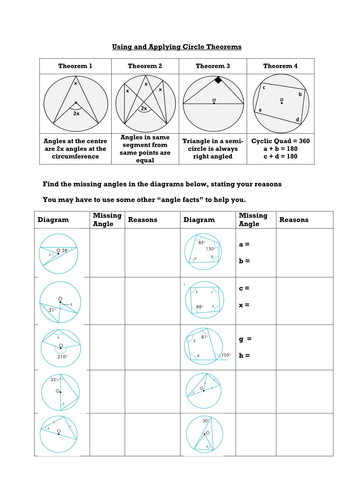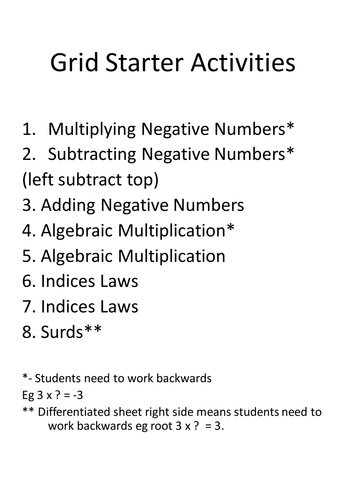
87Uploads
415k+Views
417k+Downloads
Mathematics

Classifying Quadrilaterals
A set of activity sheets and presentation/lesson for KS3 students to cover the properties of quadrilaterals. Explains line / rotational symmetry, and how/why we mark equal angles, equal and parallel sides.
The plenary works as a 'mystery' and checks learning of students by getting them to ask questions that distinguish two shapes from each other.

Negative Number Challenge
A number of activities to consolidate rules when working with directed numbers.
A good starter activity to use is an addition pyramid starting with some negative numbers
As a plenary I ask the students to tell me where they started and why....

Adding and Subtracting Fractions - Lesson
KS3 / GCSE Lesson Plan. A clear powerpoint to explain how to add/subtract fractions. Ideal for first lesson on topic.

Square Root Golf. Estimating Roots.
Useful sheet to get students estimating the roots of integers other than perfect squares, through students knowledge of square numbers.Ask students to work in pairs or small groups.
Also works well as a lead in to surds at ks4
*Update* the post it idea below works fantastically well, students can then rank the answers in terms of their closeness to the answer to further reinforce working with decimals.

Constructions Carousel
A group based recall activity for all major constructions. Read the Smart file for how to run as a lesson.

Substitution into Expressions
A task where students can challenge themselves to substitute negative numbers into algebraic expressions - their work is scored according to their complexity, by their colleagues.

Adding and Subtracting Negative Numbers
An easy way to try to explain to students why 'minus minus' actually means 'plus'. With thanks for the idea to Craig Barton.

Circle Theorems - Complete Lesson 1
An initial 3 part lesson to familiarise students with language of circles. Students can then investigate/establish first three circle theorems by drawing/measuring and using what they have learned to solve a few problems. Plenary states the proper names for the theorems and invites students to apply the theorems to further problems.

Algebraic Expression worksheet
Circular Task worksheet with a variety of activities for L5 / L6 students to complete, including
Writing Expressions
Substituting Values
Collecting Like Terms
General questions about algebra eg...why do we write in alphabetical order.
I let students tackle questions in any order then tell me which question was the hardest for them.

Angle Properties - Revision
A complete Revision lesson for putting all those angle facts together, I use this prior to teaching angles in parallel lines. Starter designed to recall previous knowledge, lots of extension opportunities and then a riddle activity for a plenary to reinforce those facts

Factors, Multiples, Primes, Bingo
A bingo activity focussing on students knowledge of classifying numbers as square, cubes, multiples, odd / even etc.
A fun activity that can generate plenty of discussion, check prior knowledge and provide an opportunity for higher level thinking on the topic.

Circle Theorems 3 - Tangents and Chords
Complete lesson for teaching theorems relating to tangents. Students draw and describe first and then apply the theorems to some exercises. As a plenary, students first fill in the missing angles before being presented with the word to accompany the exam question.

Circle Theorems - Complete Lesson 2
A lesson to consolidate and expand upon grade 'B' circle theorems. Extension work into 'A' Grade problems and an exam question as a plenary

Finding the nth term
A simple sheet to enable practice on finding the nth term of a linear sequence, the 10th, 50th and hundredth terms. Ideal for supporting GCSe foundation or as a revision homework for higher ability groups

Maths Taboo Template
A 2 page, easily customisable taboo starter / plenary activity. Change the keyword and make the forbidden words as hard or easy as you need to suit the group. 32 cards should be enough!

Area /Perim/ Volume Codebreakers
Group Challenge Lesson on Area, Volume etc.
Students work in groups of 3/4. Collective memory style task to start, then answer questions...submit codes on sheet. Review three times during lesson.
Self assessment towards end of lesson whilst you check the scores...plenary..review their self assessment and any questions that proved difficult to answer
Top Tip: Freeze your IWB or hide excel as you enter the scores to build the suspense and review progress after each time you mark.

Straight Line Graphs
A nice open ended worksheet for L6/7 students to recap Graphs at the end of a topic.
Students can start at any point on the wheel according to their confidence levels
Starts at plotting from a table of values, through calculating Gradients, then Gradient intercept richt upto finding an equation given tow co-ordinates.

Multiplication - Surds, Indices, Algebra, Directed
Grid style puzzles to assess key skill / revise
There are 6 / 8 versions of the same puzzle on each sheet. Tougher problems take out the information in the grid and students have to work backwards to find the missing term or number.

Straight Line Graphs - Alien Zapping
Students have to 'zap' as many aliens as they can by drawing three straight lines and writing their equations.
Sheets can either be laminated for multi-use or a purchase of some spaghetti allows students to experiment before they commit pen to paper!

Codebreakers
1. You need 8 groups.
2. Start with Smart file, then open xls scoresheet
3. Hand out envelopes
4. Stop after 5 mins (freeze IWB)
5. Enter codes 1-3 and review progress - cells turn green if correct on xls
6. Allow 15 Mins
7. Enter codes 4-10 plus corrections
8. Allow 5-10 mins for corrections and final 3 q's
9. Take in scoresheets, students complete a self assessment of topic (levels, targets)
10. Present Results
Plenary: open the box / review trickier questions (they will have some red against them!) - students reflect on targets and progress.
Enjoy




















